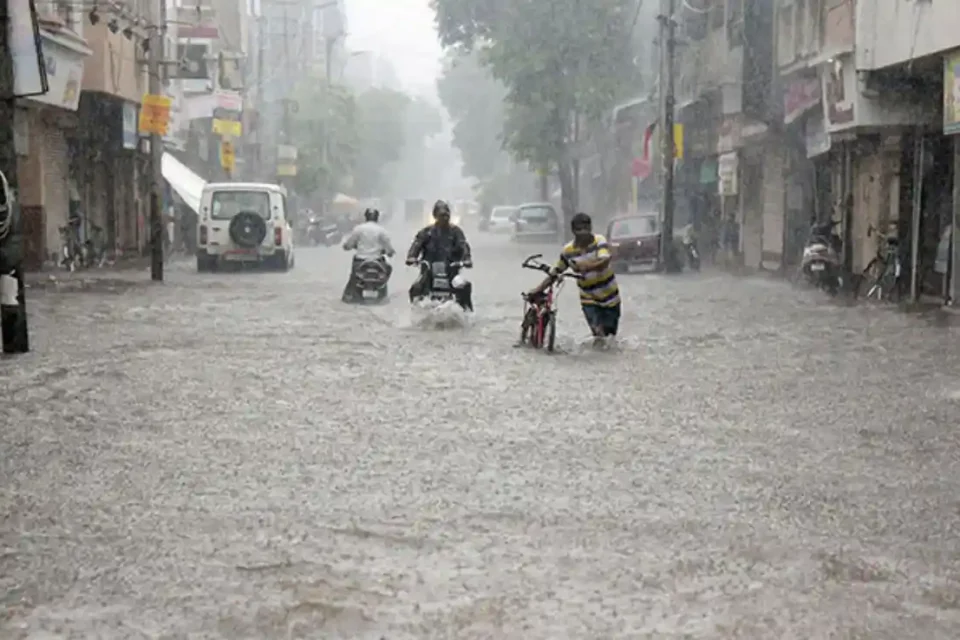Gujarat’s Bhuj Submerged: Red Alert! Four Feet Water Covers City’s Roads

The ancient city of Bhuj in Gujarat has been thrown into chaos as relentless rainfall has caused massive flooding, leaving streets submerged under nearly four feet of water. Authorities have issued a red alert, urging residents to stay indoors and prioritize safety as emergency services battle to restore normalcy. This unprecedented weather event has paralyzed daily life, raising concerns about infrastructure resilience and preparedness.
Bhuj Flood Situation: Current Updates
Over the past 48 hours, continuous heavy downpours have turned Bhuj’s bustling roads into temporary rivers. According to disaster management officials, more than 70% of the city’s main roads are inundated, halting transportation, stalling businesses, and cutting off essential services in certain areas.
Several areas, including Madhapar, Sarpat Gate, and Old Bhuj, are reported to be the worst affected, where floodwaters have entered residential colonies and ground floors of houses. Local markets remain shut, and educational institutions have been closed indefinitely as authorities assess the damage.
Government Response and Red Alert Declaration
The Gujarat State Disaster Management Authority (GSDMA) has issued a red alert warning, urging people to remain vigilant. District collectors have mobilized rescue teams, NDRF units, and fire brigades to assist trapped residents.
Relief camps have been established across safer zones in Bhuj to accommodate displaced families. Around 3,000 people have already been relocated to temporary shelters, and food packets, drinking water, and medical aid are being distributed.
Chief Minister Bhupendra Patel has assured that state machinery is fully engaged in relief operations. He has also urged citizens to avoid unnecessary travel until further notice.
Impact on Daily Life in Bhuj
The floods have caused widespread disruption in transportation, electricity, and communication networks.
- Road transport: Major highways connecting Bhuj to Anjar and Gandhidham remain blocked due to severe waterlogging. Local public buses have suspended operations.
- Railway services: Train services from Bhuj Railway Station are running with delays, as tracks are submerged in certain areas.
- Power outages: Several localities are facing electricity cuts to prevent accidents caused by waterlogging near transformers.
- Hospitals under stress: Civil Hospital Bhuj and private clinics are facing an influx of patients suffering from waterborne diseases and injuries.
Economic Losses and Business Setbacks
Bhuj, known as a hub for handicrafts and trade, is witnessing severe setbacks. Floods have damaged textile warehouses, handicraft workshops, and small industries, causing millions of rupees in losses. Many local shopkeepers reported that entire stocks have been destroyed due to water entering godowns.
The city’s tourism sector, which attracts thousands of visitors annually to sites like the Kutch Museum and Aina Mahal, is also at a standstill, with bookings canceled and travel restrictions in place.
Meteorological Insights: Why Bhuj is Facing Torrential Rains
The India Meteorological Department (IMD) attributes this deluge to the active monsoon trough combined with a low-pressure system over the Arabian Sea. Meteorologists warn that Bhuj may continue to face moderate to heavy rainfall over the next 72 hours, intensifying the risk of further flooding.
Climate experts highlight that rapid urbanization without proper drainage systems is amplifying the impact of natural downpours. With Bhuj expanding rapidly in recent years, the city’s infrastructure has not kept pace with the growth.
Voices from the Ground: Citizens in Distress
Residents have expressed frustration and fear as the city battles waterlogging.
- A local resident from Madhapar said, “The water level is almost at our chest. We had to shift our elderly parents to a relief camp. We have lost most of our household goods.”
- Shopkeepers in Sarpat Gate lamented, “We couldn’t save our stocks. The flood came in within hours, and everything was gone.”
Citizens are demanding long-term flood management solutions instead of temporary measures after every crisis.
Rescue Operations in Full Swing
The National Disaster Response Force (NDRF) has deployed specialized teams equipped with inflatable boats and life jackets. Dozens of residents stranded in high-risk areas have been rescued and shifted to safer zones.
Police and fire services are assisting in:
- Evacuating elderly citizens and children from affected homes.
- Clearing blocked drains to reduce water levels.
- Providing emergency medical kits to flood-hit families.
Drone surveillance is also being used to identify critical pockets where water levels are dangerously high.
Health Concerns Rise After Floods
Doctors warn of an imminent outbreak of waterborne and vector-borne diseases, such as cholera, typhoid, dengue, and malaria. Authorities are distributing chlorine tablets and urging citizens to boil drinking water before consumption.
The local health department has set up mobile clinics in flood-hit areas to treat patients. Vaccination drives are also being conducted to protect vulnerable groups, especially children.
Steps Residents Should Take During Floods
Authorities have issued clear guidelines to ensure community safety:
- Avoid wading through floodwaters, as they may contain sewage and dangerous debris.
- Disconnect electrical appliances to prevent shocks.
- Store dry food and clean drinking water in airtight containers.
- Move to higher floors or designated shelters if water levels rise further.
- Stay updated with weather alerts and government advisories.
Future Preparedness and Infrastructure Needs
Experts emphasize that Bhuj must adopt modern drainage systems, flood barriers, and urban planning strategies to reduce the impact of future floods. Rainwater harvesting and improved sewage systems are critical to managing excessive rainfall.
Long-term solutions also involve strengthening disaster management cells, investing in weather prediction technologies, and raising community awareness about safety measures.
Conclusion: Bhuj’s Struggle and Hope for Recovery
The ongoing crisis in Bhuj underscores the urgent need for sustainable urban infrastructure and disaster resilience. While relief efforts are underway, the floods have once again highlighted the vulnerability of rapidly growing cities in India to climate-driven natural disasters.
As Bhuj begins the arduous journey of recovery, it is crucial for authorities, citizens, and policymakers to work hand-in-hand to ensure that such devastation does not repeat in the future.